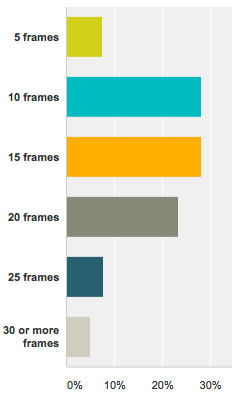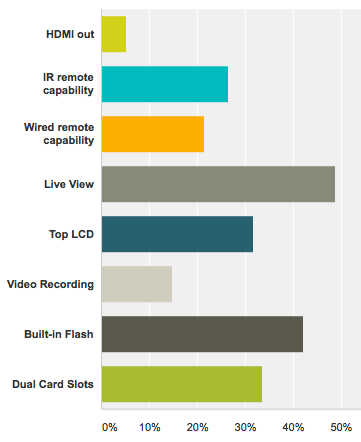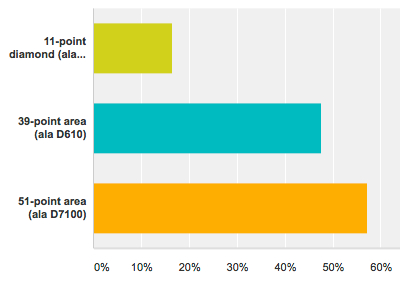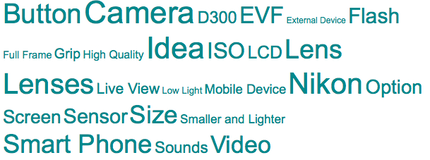(commentary)
If you weren’t lying when you filled out my survey, my site would have sold over a million dollars worth of gear in less than two hours from the time I posted the survey. Think about that for a minute (for the Nikon folk reading this in Tokyo, that would be 100m yen, or about 1m yen a minute ;~). And in less than 24 hours that number was in the multi-millions.
Before I get to the survey results, let me go back and tell you why I did this particular questionnaire and specified the products the way I did. I had a method to my madness, and some very specific thoughts behind what I attempted to do:
- The Apple Thing. Apple is notorious at taking things out of products. Yes, they iterate products and make them better, but they also are on a constant hunt for the detritus that piled up and doesn’t really need to be there. Their goal is always to solve the user problem directly, not in layers of stuff you have to wade through. Moreover, they have no problem ditching things that people think are sacred, but they’re actually not using.
Ditching menus was one of those things that came to mind. Why do we have menus? Because the camera companies keep adding more features and complexity into the product. Do we actually use those menus? Sure, because we have to in order to get to one of those new features. The Nikon 1 was a great example of doing exactly the wrong thing: putting all the controls into the menus and having no external controls solved Nikon’s manufacturing problems (fewer parts, fewer cables between parts, etc.), but it actually made the photographer’s problems while shooting more difficult. You basically missed shots because you didn’t have the controls you needed instantly accessible and changeable.
Consider if the auto makers kept adding features to your car, but only put them in menus. Get rid of the turn signal stalk and the windshield wiper stalk on the steering wheel. Makes the steering wheel cheaper and easier to make, but if the customer now has to press a Menu button and navigate to “Turn Left Signal” and then navigate to “On” or perhaps navigate to “Wipers” and the sub-menu option “Intermittent” and then the sub-choice “Every 2 seconds” this wouldn’t be very beneficial to driving, would it? Well, that’s where we are with cameras: except at the pro level where you can set virtually everything via external controls, current camera designs are not very beneficial to taking pictures.
Indeed, I think that’s really what the “retro” craze is all about. It’s not so much about having your father’s camera’s dials, it’s about having controls that allow you to directly configure the camera, just like in the old days.
So the first part of my DSLR redesign was involved with taking out all those things that take you away from shooting and put them back where they belong: directly under your control as you shoot. By touch. I could go into more detail of how that would work, but I think most of you seemed to figure it out from what I wrote. If a camera company wants to pick my brain on this, I’m available to consult more on this. - The Silicon Valley Thing. Some of you figured it out from my slightly deceptive description: the reason why WiFi (or maybe fast Bluetooth) is in the camera and that the configuration is done on another device is simple: it’s the quickest way to get us to programmable cameras. I didn’t specifically mention a function button, but I’d probably put one of the camera because of this. What could be better than a truly programmable function button? ;~)
Sure: two programmable function buttons!
But let’s start simple, shall we? ;~) Writing software for Windows, OS-X, Linux, iOS, and Android that allows a user to push a new feature over to the camera is going to be quicker and easier than trying to cram a fully programmable system into the camera itself. Moreover, as I noted, I’d be using that connection to allow setting the camera’s custom settings, too, and that means saving as many iterations of custom settings as you’d like, not the limited number we have today. I would further assume the program at the other end of that WiFi signal would be able to reach into its file system (or cloud) and push any special configuration you’ve ever created over to the camera in a jiffy.
Note that a lot of you grumbled about “having only C1/C2 isn’t enough.” Just like right now everyone grumbles about only having four banks of settings and having those banks not connected and not actually having those able to control everything you can set in the camera. Well, the WiFi connection solves that problem permanently. You’re not limited to the number of ways you can configure the camera with a button. Only difference is that the button is on your smartphone (or tablet or computer), not the camera.
And oh, by the way, we can enter EXIF and IPTC information on that connected device ;~). From pre-created files, even. Are you still grumbling about having to use a smartphone with your camera?
I would also propose going further. While my camera as specified can select between Picture Controls with a control built into the camera (not via menu), the biggest issue I have with Picture Controls is that they’re limited. We have only a few bases to change only a few parameters with. I propose allowing you to completely create a new Picture Control on the smart device connected to your camera and pump that over as a selectable PC via the camera’s external control. I suppose if we were to get really sophisticated about this, the camera could shuffle a live view image over to the other device and let you modify the Picture Control in real time visually.
- The Photographer Thing. You’ll note that my specified lenses were modest, but form a complete set from wide angle to moderate telephoto. Technically you can go from 15-200mm equivalent with three lenses, supplementing that with faster lenses at your favorite focal lengths from 24-85mm. In other words, the focal lengths that we all learned with and regard as primary importance.
You can certainly supplement that with any F-mount lens made in the AI/AI-S and later era, but I wanted a “kit” of components that were sized and built appropriately for the basic job of photography. Not convenience. But photography. This is the problem with Nikon’s current DX products: they’re not complete photographically because of the lens set. They’re complete for convenience only.
Coupled with all the photographic controls being at your fingertips at all times—and we can assume that I’d configure the viewfinder to tell you as much about those controls as possible—we should be able to take photographs the way we learned to take photographs.
And if we wanted to refine, redefine, or augment that, we can. Via that WiFi connection and the smart software at the other end that can pump new configurations, settings, curves, data, and more into the camera.
Okay, you want to know the results of the survey. After 20 hours there were 3727 responses. Looking at the unique visitors to the page during that period, a little less than 10% of those hitting that page pulled up the survey and entered responses.
Here are your answers to specific questions:

For frame rate, we got a fairly distinct bell curve centered at 5 fps. While not always true, bell curves generally indicate that the question is reasonably “settled” amongst users: they know what they want and need. Since quite a lot of you thought I was describing a D300s replacement camera (I wasn’t), it’s curious that we didn’t see a higher mid-point for this curve. Note that Nikon’s recent high-end cameras (D610, Df, D800, D7100) all fall near the middle of this curve. I’d have to guess that Nikon’s own statistics say the same thing as your answers suggest.
Buffer size, however, didn’t get as much clarity:

Most of you would be served with something in the 10-20 frames realm, which given the 5 fps preferred frame rate is 2 to 4 seconds of continuous shooting. Again, that seems to be about where the recent Nikon cameras tend to be, though the D7100 is at the short end of that stick.
This brings up another problem with surveying users: are you getting what you actually created mimicked back in the results? In other words, if you make cameras with 5 fps frame rates and 2 to 4 second buffers, is that the answer you get back from the user as to what they want when asked directly? I think all of us are aware that buffer stall is a highly prevalent critique of many recent cameras, yet the answers here don’t really reflect that. On the other hand, the 60 fps for one second limitation of the Nikon 1 I can totally live with because it gives me something unique. This is one reason why when you’re a product manager and you’re really trying to figure this stuff out you have to do plenty more than just asking basic questions like this. You have to test these answers to make sure you’re not missing something important.
My guess is that if I put prototype cameras into your hands with different artificial buffer limits we’d get a different set of answers. 10 frames at 5 fps seems low to me. But maybe that’s right. I wouldn’t know without testing the results some more.
I asked about a few features that I had either pulled from the camera spec or weren’t obviously included:

I was a bit surprised by the flash and dual card slot numbers (remember, this is supposed to be a smaller than D3300 camera). The live view and other numbers didn’t surprise me at all. This is where product design gets tricky. There’s this temptation to include the kitchen sink: “if we’re going to include live view because so many people want it then video is an easy extension of that and that probably means we need an HDMI connector…” It’s called feature creep for a reason.
I think you probably realize that what I was attempting here is the opposite of feature creep: I was trying to pull as much out of the camera itself as I could while still letting it perform at near pro levels as a still camera. Think of it as my attempt to create a MacBook Air. 90% of what you need in a laptop, but cut down in size, weight, and features to something much more manageable. There’s the old adage that the sum of the parts should be more than the sum of the parts (e.g. 1 + 1 > 2). But it works the other way, too: if you take away parts you should end up with something more than what you took away (e.g. 2 - 1 > 1).
We’re in the long tail for sum of the parts for DSLRs. Adding autofocus to SLRs was a big gain. Making digital SLRs was a big gain. Getting to 24mp pixels from 2.5mp was a big gain. But all these feature creep things are not really adding much. To use my numeric examples, it’s as if 50 + 1 = 50.5. And 50.5 + 1 = 50.6, and so on. What I’m attempting to do is something akin 50 - 10 = 49.
So whether those features I listed above make it into the final result depends a lot on how I analyze their importance to the sum of the product.
My final spec question was about focus, and the results were pretty predictable:

Let’s move on.
Of those filling out the survey, 34% said you’d buy this camera at US$1000 as specified (thanks for your trust, guys ;~). 37.5% of you needed to have the options you specified in the above answers added before you’d buy it. Another 18.6% of you wanted it at a lower price (tightwads! ;~). Only 10% said you wouldn’t buy it. That startled me. I knew that I was going down a path that should resonate with this site’s visitors, but I didn’t think that many of you would follow me. Wow.
Those lenses? Here’s how many of those you’d grab:
- 16mm f/2: 60.7%
- 18mm f/2: 15.7%
- 24mm f/2: 46.3%
- 35mm f/2: 40%
- 58mm f/2: 49.9%
- 10-20mm f/4: 52.9%
- 16-50mm f/4: 59.7%
- 50-135mm f/4: 65.3%
Oh dear, Nikon, do you see it? I do. I think the rest of you probably do. Pardon me if I shout for a moment: WHERE THE HECK IS THE 16MM DX PRIME LENS? Notice how 18mm isn’t exactly resonating with this group, yet that’s the number we keep getting on virtually every new convenience zoom Nikon makes. Oh, and WHERE THE HECK IS THE 70-200MM EQUIVALENT DX ZOOM?
I’m still looking at and analyzing the other 3000 text comments I got about my proposed offerings. Instead I offer two word clouds for those open-ended questions:
 and
and

After the survey opened and I was receiving results I added a question about what people who were complaining about no menus were actually using the menus for. Here’s that word cloud from 900+ responses:

Many of those things are dealt with directly in the controls I propose: focus, ISO, file format, mode, picture controls, image size, and white balance. Others are defined by you via the WiFi connection prior to going out shooting and then choosing via custom setting: banks, custom functions, custom settings, etc. Others would be dealt with by better viewfinder/top LCD/rear LCD information: for instance battery info.
But I asked this question as a control towards refining the design. There were a few things I left ambiguous (how you’d change sharpness levels for JPEGs, for example). Before I’d go too deeply into finalizing such a design as I propose I’d want to make sure that I’m dealing with all the 90% cases, and as many of the 99% cases as possible.
Going into this experiment my hypothesis was that I’d find a reasonable amount of support for my little simplified DSLR. I was wrong. I found a humungous level of support. Overwhelming, really.
Thing is, a lot of Nikon prosumer users are leaking to products such as the Fujifilm X-T1, Olympus E-M1, or even the Sony A7 models. The camera I specified would stop one heck of a lot of those leaks, I think. Unlike my previous experiment with a totally programmable, communicating, and modular camera design, the current design I’m proposing gets us much of the way there with little to no modification of many of the things currently in Nikon’s recent DSLR designs.
So here’s the thing: if an alleged hack blogger who’s supposedly just looking for clicks for his pathetically small site could virtually sell a million dollars worth of equipment in two hours, what could the right team at Nikon do?





